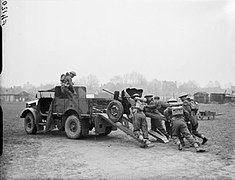Bedford MW
| Bedford MW | |
|---|---|
 Bedford MWD 15cwt truck with Rhodesian troops of the 60th King's Royal Rifles, Western Desert, 1942. | |
| Type | General service truck |
| Place of origin | United Kingdom |
| Service history | |
| In service | 1939–late 1950s |
| Used by | British Army, Royal Air Force & Royal Navy |
| Wars | Second World War |
| Production history | |
| Designer | Bedford Vehicles |
| Designed | 1937 |
| Manufacturer | Bedford Vehicles |
| No. built | More than 66,000 |
| Specifications | |
| Mass | 2.1 long tons (2.1 t) |
| Length | 14 ft 4 in (4.37 m) |
| Width | 6 ft 6 in (1.98 m) |
| Height | 7 ft 6 in (2.29 m) |
| Crew | 2 |
| Engine | Six-cylinder inline Bedford OHV 210 cu in (3.5 L) petrol 72 bhp (54 kW) at 3,000rpm |
| Payload capacity | 15 long cwt (760 kg) |
| Drive | Wheeled 4x2 |
| Transmission | 4 forward, 1 reverse |
| Suspension | Live axles on semi-elliptical multi leaf springs |
| Maximum speed | 40 mph (64 km/h) |
| References | Chris Bishop[1] & Pat Ware[2] |
The Bedford MW was a general service truck used by the British Armed Forces during the Second World War.
Design[edit]
The Bedford MW was a 15 cwt (760 kg) 4x2 truck, powered by a Bedford 72 bhp (54 kW) six-cylinder inline 210 cu in (3.5 L) petrol engine through a four speed transmission.[1][2]
Despite lacking four wheel drive and so being unsuited for off-road use, the MW's powerful engine, short wheel base, low centre of gravity and relatively light weight gave it excellent acceleration and almost sports car like handling.[2]
The early MWs were open cabbed with a folding windscreen and a collapsible canvas tilt, from 1943 an enclosed cab with doors and perspex side screens was added, retaining the canvas top. The vehicle had a distinctive wide bonnet, necessitated by the need to accommodate a special extra large air filter that was never fitted to production vehicles.[1][2]
History[edit]
In 1935 the War Office issued specifications for a new 15 cwt 4x2 military truck for service with the British Army, inviting manufacturers to submit designs to take part in annual comparative trials in north Wales, one entrant was a modification of a Bedford Vehicles 2-ton rear wheel drive lorry. Following these trials Bedford fitted a larger radiator and larger tyres, the trials were repeated in 1936 after which Bedford modified the chassis to increase ground clearance and installed a new engine cooling system. For the 1937 trials a new special Bedford WD-1 prototype was produced with a 15 cwt payload, it performed admirably and in 1938 the eventual 72 bhp (54 kW) engine was installed.[1][2]
Between 1939 and 1945 Bedford produced over 66,000 MWs, the vehicles remained in British service until the late 1950s.[1][2]
Use[edit]
The MW was intended mainly to be a workhorse for the British Army's infantry battalions, but throughout the war it was adapted to a number of roles and was eventually also used by the Royal Air Force, Royal Navy, other government departments and some overseas customers.[1][2]
Variants[edit]
The Bedford MW was built in multiple variants including:[2]
- Bedford MWD cargo truck with General Service body approx 6 by 6 ft (1.8 by 1.8 m). Main transport of an infantry battalion.[3][full citation needed]
- Bedford MWC water tank truck
- Bedford MWT anti-aircraft gun tractor
- Bedford MWG QF 2-pounder or 20mm Oerlikon portee
- Bedford MWR radio truck
- Bedford MWV Royal Air Force signals van
Gallery[edit]
-
Water-carrying trucks of XII Corps filling up at a water point, 12 July 1944.
-
Bofors gun of 89th Light Anti-Aircraft Regiment stranded in flooded land at Elst in Holland, 15 December 1944.
-
Bedford MWD trucks in Valkenswaard, the Netherlands
-
1st Royal Irish Fusiliers with French 25mm 34 SA anti-tank gun on the back of a Bedford MWD, January 1940.
-
Bedford MWR in camouflage of 1st Czechoslovak Armoured Brigade on the 75th Anniversary of Operation Anthropoid
-
Bedford MWC water tank
-
Loading a Hotchkiss 25mm SA 34 anti-tank gun onto the back of a Bedford MWG, April 1940
References[edit]
External links[edit]
- Bedford MWC at Danish army vehicles







